Today we’re taking a look at the new LEAK Audio Stereo 130 + CDT. They’re available for $1,195 USD and $895 USD respectively.
Note: Leak Audio’s local Australian distributor, Audio Visual Revolution, kindly arranged for a review sample of the Stereo 130 and CDT to be sent our way. Our thanks go out to them for the support, and we’ll be sending both units back their way post-review.
All-in-one, or one of each?
I, like many of you (I suspect), have had many a separate audio component move onto, and subsequently off my desktop over the years. Different digital and analogue sources, differing amounts of desktop real-estate, and differing room and furniture design choices have meant that I’ve played many a game of ‘Tetris’ mixing and matching devices…not to mention the hours spent wrangling the viper’s nest of cables that sits behind my desktop. At one point I’ve had no less than the following arrayed in various stacks on the smallish timber tabletop in front of me: a phono pre-amp; a CD player; a DAC; a streamer; a solid-state headphone amplifier; a tube pre-amplifier; a source-switcher; and a stereo power amplifier. Throw-in a monitor plus laptop, and it hardly leaves much room for anything else.
There are certainly benefits to using separate components in your audio chain. For starters, you can upgrade a single component at a time to your liking, should you wish to upgrade it. You can also tailor your system’s sound to your liking by mixing and matching various equipment pairings. On the flip-side, a single integrated unit allows for a clean, contained system and removes the need for multiple power plugs, interconnects and ‘boxes’. I’ll take the latter any day…if the right product happens to come along, and the manufacturer packs the right capabilities and performance into its box.
Headphone vs Speaker listening
Being an aficionado of both headphone and speaker listening I’ve often toyed with the idea of getting rid of the lot and having a ‘super-integrated’ device of sorts take their place. “Blasphemy!” I hear some of you say. Yes, many integrated amps and receivers have less-than-stellar headphone sections, their 6.3mm jacks often being simply hooked up to the main power output of the amplifier with a simple resistor in the signal path. A high output-impedance is generally the result – ok if you have a pair of high-impedance dynamic headphones on your hands, but less-than-optimal if you want to switch to some low-impedance, low-sensitivity planars.
I also need to admit that despite being a headphone reviewer, I’ll generally always listen to speakers over headphones…other things being equal. Nothing beats the dynamic, visceral impact of speakers. I have a pair of KEF LS50 speakers set-up on stands either side of my desk, angled-in towards me with the centre of the coaxial, two-way speakers levelled at ear height. The mastering engineer of the album that you’re enjoying generally intends both of your ears to be able to hear both the left and right speakers – something that headphones miss out on – unless some sort of crossfade is introduced in either the analogue or digital realm before it reaches your ears.
However, conditions aren’t always ‘equal’, and that’s where headphones come into play. For starters, they spare your cohabitants and neighbours from being able to hear what you’re listening to. And then there’s the room – unless you’re listening in an open field or an anechoic chamber, the reflections of the room that your speakers are in will always add undesirable effects that are difficult to tame, requiring physical damping, digital signal processing, or a mix of both.
Neither headphone nor speaker listening is ‘better’. Headphones are simply a more intimate and often a more revealing kinda listening experience, whereas speaker listening simply feels closer to being there. There is a time and a place, and benefits to either. And that brings us back to the aforementioned device conundrum – if you are listening to both you’ll want to be able to power their transducers adequately, and to be able to switch between them seamlessly when circumstances change.
Leak Audio Stereo 130 – Art Deco revival
Leak Audio is a name you might not immediately recognise, but if your Grandfather had a penchant for classic British hifi (like mine certainly did), then he might have owned a piece of equipment from H.J Leak & Co LTD at some point. Founded in 1934, the company was responsible for producing many pieces of well-regarded audiophile equipment over the years including the seminal 1963 LEAK Stereo 30 – their first all-transistor model, with the ‘30’ signaling the combined power of the 15-watts being produced in each channel.
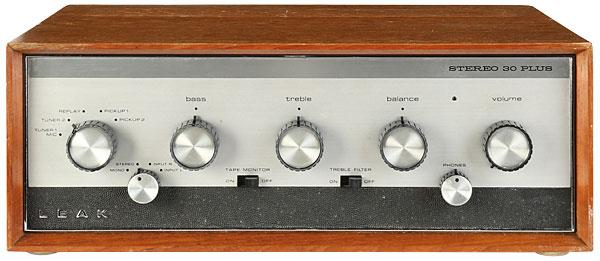
With the company sadly folding some 40 years ago, holding group International Audio Group (IAG), manufacturers of such brands as Wharfedale, QUAD and Audiolab (to name a few), saw a gap in the market for retro-inspired, quality audio components and therefore revived the art-deco ‘LEAK’ logo with a 21st-century take on their most famous product: the LEAK stereo 130.
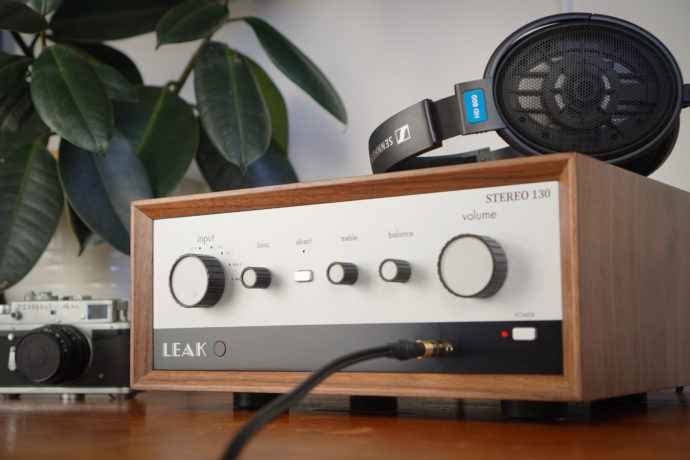
At a glance, the $1,195 USD Stereo 130 is very much the spiritual successor to the Stereo 30, with a similar-coloured black + silver fascia packing large, and plastic dials that wouldn’t look out of place on the instrument panel of a Thunderbirds rocket ship. The Stereo 130 comes encased in a real walnut enclosure which is an optional extra…but let’s not kid ourselves – you’re very much buying into this product for its vintage appeal as for its capabilities, right? Speaking of which, IAG has certainly equipped the LEAK Stereo 130 for 2020 and beyond, including a host of digital and analogue features that ought to appeal to someone looking for an ‘all-in-one’ solution.
Digital smarts
In the digital realm, the LEAK 130 has been equipped with an ESS Sabre32 Reference ES9018K2M digital-to-analogue converter, allowing it to decode PCM up to 384kHz from its USB input and up to 192kHz from its coaxial or (two) optical inputs. DSD64, 128, and 256 are also catered for. Understanding that convenience is a big selling factor for both the general punter and modern-day audiophile, the LEAK Stereo 130 also includes Bluetooth support, supporting the high(er) resolution aptX codec.
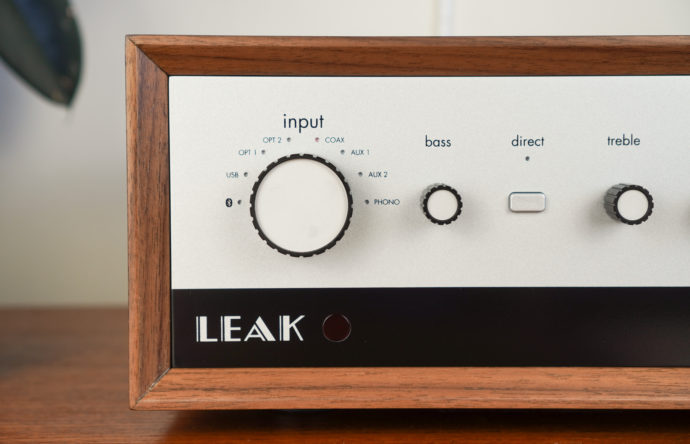
Classic analogue capabilities
If you’re wanting to feed the Stereo 130 with something other than 1’s and 0’s via the on-board Sabre32 DAC, then you’re given the option of two sets of single-ended RCA analogue-in connections plus a phono connection for Moving Magnet (MM) cartridges. A single-ended pre-out is also included, allowing the Stereo 130 to act as a pre-amplifier upstream of a stereo power amplifier, or a pair of powered monitors. Like many stereo receivers of yesteryear, a pair of tone control knobs allow the listener to fine-tune bass and treble levels to their liking, and an additional knob controls left/right balance. Those purists among you who see tone controls as something akin to heresy will be relieved to know that these can be bypassed using the ‘Direct’ switch on the front panel.
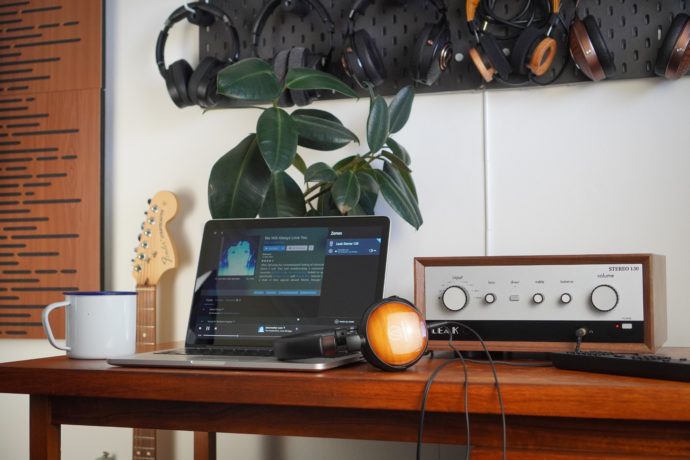
As an integrated amplifier, the new LEAK amplifier is intended to drive speakers first and foremost, which is presumably why most punters will want to take one home. Two pairs of binding posts allow the Stereo 130 to provide a healthy 45 Watts-per-channel of Class A/B power to 8-ohm speakers, which increases to 65 Watts-per-channel for 4-ohm speakers. What piqued my interest, as a headphone reviewer, was the fact that this terrific-looking device also packs a discrete headphone amplifier featuring current-feedback technology. LEAK claims that the dedicated onboard headphone amplifier is “Equal in performance to standalone headphone amplifiers, beyond the price-class of this complete system”.
Big claims indeed. But, if it does stack-up in the performance stakes then we may well have nearly the perfect desktop box on our hands, right? Chatting further with the LEAK team about the capabilities of the Stereo 130’s headphone amplifier, they explained that its power output and performance look something like this:
- Maximum headphone power output:
- Into 32 ohms (THD:0.003%): 600mW
- Into 150 ohms (THD:0.003%): 150mW
- Into 250 ohms (THD:0.003%): 90mW
- Total Harmonic Distortion: <0.006%
These are respectable, if not earth-shattering figures for a standalone headphone amplifier, let alone an integrated stereo receiver, and ought to power most headphones to ear-shattering levels.
LEAK CDT CD Transport
It’s incredible to think of the humble Compact Disc as ‘vintage’ but the LP’s less-sexy digital cousin was actually first invented in 1979, and has gone on to sell over 200 billion units worldwide subsequently. As a child of the 90’s I certainly put a lot of time and hard-earned money into building a CD library, and I’ve amassed hundreds of albums over the years. Every time I move house I contemplate donating them to the local charity store (rather than slipping a disc in my back trying to move them), but each time I firmly decide that they’re staying put. I reckon the old Compact Disc is an awesome format. For starters, it’s a perfect digital artifact with an audibly-perfect 16-bit/44.1kHz sample rate and a theoretical dynamic range of 96dB. Next, they’re reasonably portable (yes, I had one of those CD holders on my car’s sun visor) while still giving you the artist’s cover art, lyrics, and other accompanying documentation. CD’s are pretty cheap these days too. I grab a couple every now and then from my local charity store for a buck or two each time. Not bad.
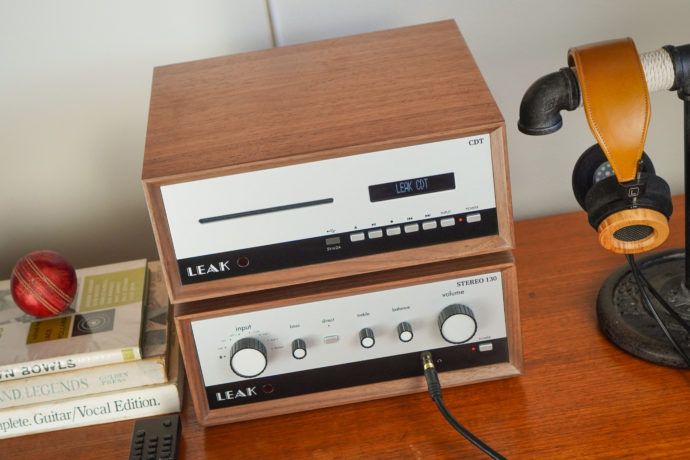
But for me, CD’s beat streaming every time thanks to the fact that they’re simply a physical experience. Like LPs, you get to pick them out from the shelf, load them into your player, and then listen to an album from go-to-whoa without interruption (providing it’s not scratched, that is…). And that experience is only added to when the player is encased in the same matching walnut enclosure as the Stereo 130, which is precisely what LEAK has done with their new $895 USD LEAK CDT – the companion CD Transport for the Stereo 130. The CDT is a single-loading CD Transport – not player – with no analogue-out, rather it sends its digital signal via optical or coaxial to a downstream DAC for deciding into analogue. The CDT is capable of spinning CD, CD-R, and CD-RW discs as well as the unusual option of playing .WAV, .MP3 .WMA and .AAC files from a USB thumb-drive which can be inserted via the front-panel.
Let’s take a look and see what the Stereo 130 and CDT are like to live with, and more importantly – how they sound.
The review continues over the jump on page 2.






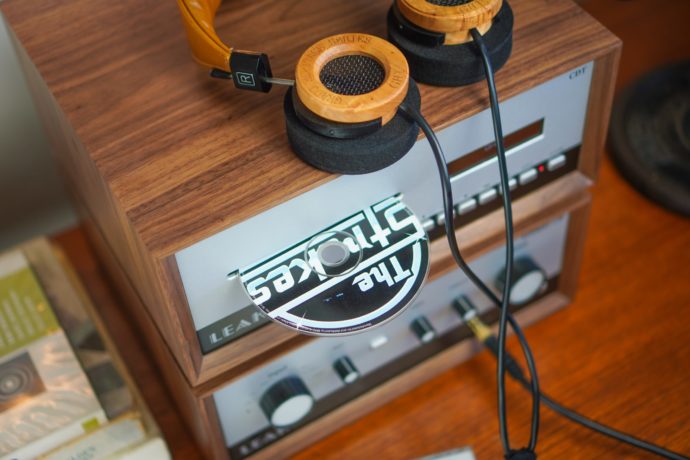

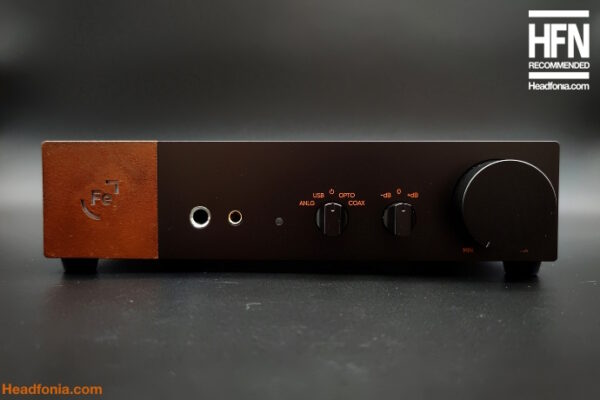
Aryan Bansal
Great article matty Graham. Thanks for sharing informative article.
Matty Graham
My pleasure Aryan, thanks for reading.
Kevin Anderson
Enjoyed your review Marty. Have progressed to a Leak 230 with the Wharfedale Lintons. Great sound for my ageing ears. Now considering the Leak CDT to complement the set. Thanks for your informative commentary.
Lieven
Thanks for the comment